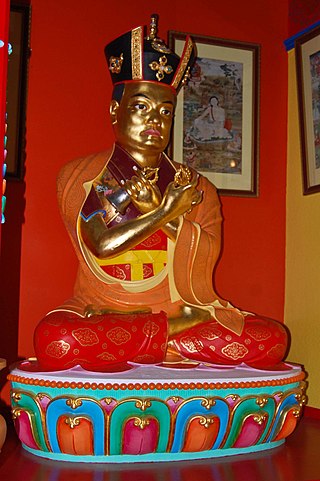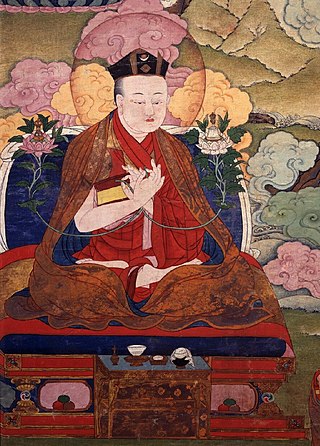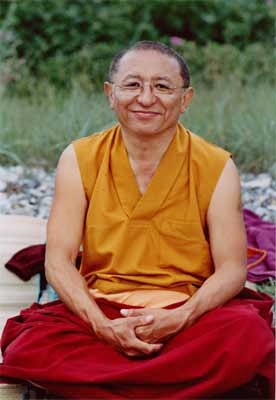Buddhist Leader

| Part of a series on |
| Tibetan Buddhism |
|---|
 |
|
Practices and attainment |
Institutional roles |
History and overview |
Ayang Tulku Rinpoche is a Tibetan Buddhist lama.

| Part of a series on |
| Tibetan Buddhism |
|---|
 |
Ayang Tulku Rinpoche is a Tibetan Buddhist lama.
Ayang Tulku Rinpoche (born 1942) was born in a nomadic family in Eastern Tibet and holds both Drikung and Nyingma lineages. The young boy was recognised by a delegation of high lamas, including the 16th Gyalwang Karmapa, Ayang Drubchen Tenpai Nyinpa, Nelong Drubchen, Traleg Kyagbon, and the tutor of Drikung Kyobgon Chabra Rinpoche, as the mind (wisdom) emanation of Terton Rigzin Chögyal Dorje and the seventh incarnation of the founder of the Ayang Monastery in Eastern Tibet (Kham), which was built around 1580 C.E. as a branch of the main Drikung monastery. He took his monk's vows and received his early training at Drikung Thil Changchub Ling, the main Drikung Kagyu monastery in central Tibet. From 1951 to 1955 he studied at Drikung Nyima Changra Philosophical College in central Tibet. From Khenpo Tsense Sangpo he received all the Nyingthig initiations and teachings as well as his first Phowa teaching according to the Nyingma tradition. From the great Drikung lama Nyizong Tripa he received all the initiations of Rinchen Ter Dzod and Kagyu Nag Dzod. From his own monastery, Ayang Thupten Rinpoche, who was also the tutor of the head of the Drikung lineage, bestowed on him teachings of the Six Yogas of Naropa and Mahamudra. He received teachings on Drikung Phowa from both Drikung Kyobgon Chetsang Rinpoche and Drikung Kyobgon Chungsang Rinpoche, the heads of the Drikung lineage, during the Phowa Chenmo, which takes place only once every twelve years. He was given the Upadesha (pointing out instructions) by the great Nyingma yogi Rahor Chödra Rinpoche.
Ayang Rinpoche is considered a foremost authority on Buddhist afterlife rituals and Tibetan Pure Land Buddhism; he gives teachings and initiations to the practice of phowa in Tibetan and English annually in Bodh Gaya, India and across the world in Europe, Asia, Australia and North America. He has established a school, medical clinic and education sponsorship program for children in Tibet and a variety of community development projects for Tibetans in India. He is also the founder of the Opame Khilkor Choling (The Amitabha Mandala Temple and Retreat Center) with 16 temples and a 64-cottage retreat center dedicated to Buddha Amitābha that overlooks the Kathmandu Valley in Nepal and Thupten Shedrub Jangchub Ling Monastic Institute at Bylakuppe, in the Indian State of Karnataka.
Chöje Ayang Rinpoche has been giving teachings around the world, at locations like Hong Kong, Paris, San Jose, Sydney, Taipei, Toronto, etc. Besides his famous Phowa courses, he has also been lecturing advanced Vajrayana courses like, but not limited to, Higher Level Buddha Vajrasattva teachings (wisdom treasure of Rigdzin Tsewang Norbu), Buddha Amitābha 10 levels teachings (Namchö tradition), and True Nature of Mind “pointing out” instructions. [1] [2] [3]
Phowa Teachings Contents: [4]

Tibetan Buddhism is a form of Buddhism practiced in Tibet, Bhutan and Mongolia. It also has a sizable number of adherents in the areas surrounding the Himalayas, including the Indian regions of Ladakh, Sikkim, and Arunachal Pradesh, as well as in Nepal. Smaller groups of practitioners can be found in Central Asia, Xinjiang, Inner Mongolia, and some regions of Russia, such as Tuva, Buryatia, and Kalmykia.

The Gelug is the newest of the four major schools of Tibetan Buddhism. It was founded by Je Tsongkhapa (1357–1419), a Tibetan philosopher, tantric yogi and lama and further expanded and developed by his disciples.

The Kagyu school, also transliterated as Kagyü, or Kagyud, which translates to "Oral Lineage" or "Whispered Transmission" school, is one of the main schools of Tibetan Buddhism. The Kagyu lineages trace themselves back to the 11th century Indian Mahasiddhas Naropa, Maitripa and the yogini Niguma, via their student Marpa Lotsawa (1012–1097), who brought their teachings to Tibet. Marpa's student Milarepa was also an influential poet and teacher.

Drikung Kagyü or Drigung Kagyü is one of the eight "minor" lineages of the Kagyu school of Tibetan Buddhism. "Major" here refers to those Kagyü lineages founded by the immediate disciples of Gampopa (1079-1153), while "minor" refers to all the lineages founded by disciples of Gampopa's main disciple, Phagmo Drupa (1110-1170). One of these disciples, Jigten Sumgön (1143-1217), is the founder of Drikung.

The Rimé movement is a movement or tendency in Tibetan Buddhism which promotes non-sectarianism and universalism. Teachers from all branches of Tibetan Buddhism – Sakya, Kagyu, Nyingma, Jonang, Gelug, and Bon – have been involved in the promoting Rimé ideals.

Jamgön Kongtrül Lodrö Thayé, also known as Jamgön Kongtrül the Great, was a Tibetan Buddhist scholar, poet, artist, physician, tertön and polymath. He is credited as one of the founders of the Rimé movement (non-sectarian), compiling what is known as the "Five Great Treasuries". He achieved great renown as a scholar and writer, especially among the Nyingma and Kagyu lineages and composed over 90 volumes of Buddhist writing, including his magnum opus, The Treasury of Knowledge.

Karma Kagyu, or Kamtsang Kagyu, is a widely practiced and probably the second-largest lineage within the Kagyu school, one of the four major schools of Tibetan Buddhism. The lineage has long-standing monasteries in Tibet, China, Russia, Mongolia, India, Nepal and Bhutan, with current centres in over 60 countries. The spiritual head of the Karma Kagyu is the Gyalwa Karmapa; the 2nd among the 10 Karmapas had been the principal spiritual advisors to successive emperors of China. The Karma Kagyu are sometimes called the "Black Hat" lamas, in reference to the Black Crown worn by the Karmapa.
In Tibetan Buddhism, Ngöndro refers to the preliminary, preparatory or foundational practices or disciplines common to all four schools of Tibetan Buddhism and also to Bon. They precede deity yoga.

Dzongsar Khyentse Chökyi Lodrö was a Tibetan lama, a master of many lineages, and a teacher of many of the major figures in 20th-century Tibetan Buddhism. Though he died in 1959 in Sikkim, and is not so well known in the West; he was a major proponent of the Rimé movement within Tibetan Buddhism, and had a profound influence on many of the Tibetan lamas teaching today.
Phowa is a tantric practice found in both Hinduism and Buddhism. It may be described as "transference of consciousness at the time of death", "mindstream transference", "the practice of conscious dying", or "enlightenment without meditation". In Tibetan Buddhism phowa is one of the Six yogas of Naropa and also appears in many other lineages and systems of teaching.

Kyabje Dudjom Rinpoche Jigdral Yeshe Dorje was known simply as Dudjom Rinpoche. He is considered by many Tibetan Buddhists to be from an important Tulku lineage of Terton Dudul Dorje (1615-1672), and was recognized as the incarnation of Terton Dudjom Lingpa (1835-1904), a renowned treasure revealer. He was a direct incarnation of both Padmasambhava and Dudjom Lingpa. He was a Nyingma Householder, a yogi, and a Vajrayana and Dzogchen master. According to his secretary Khenpo Tsewang Dongyal and many others, he was revered as "His Holiness" (Kyabje) and as a "Master of Masters".

Rangjung Dorje (1284–1339) was the third Karmapa and head of the Karma Kagyu, the largest sub-school of the Kagyu tradition. He was an important figure in the history of Tibetan Buddhism, who helped to spread Buddha-nature teachings in Tibet.
Khentrul Lodrö Thayé Rinpoche is a Tibetan Buddhist lama of the Nyingma school. He is the abbot of Mardo Tashi Choling in Eastern Tibet, where he established a retreat center and shedra, a formal Buddhist monastic college, under the direct guidance of his teacher, Khenchen Jigme Phuntsok Rinpoche. He directs the education and spiritual practice of three hundred monks, seventy advanced-degree candidates, sixty children, and twenty full-time retreatants.
The Khamtrul tulku lineage is part of the Dongyud Palden section of the Drukpa Lineage of the Kagyu school of Tibetan Buddhism.
The name Karma Chagme refers to a 17th-century Tibetan Buddhist (Vajrayāna) lama and to the tülku lineage which he initiated. Including the first, seven Karma Chagme tülkus have been recognized. The Neydo Kagyu sub-school of the Karma Kagyu was established by the first Karma Chagme, Rāga Asya.

Chökyi Nyima Rinpoche is a Tibetan Buddhist teacher and meditation master. He is the abbot of Ka-Nying Shedrub Ling Monastery in Kathmandu, Nepal. He is the author of several books, founder of meditation centers around the world, and an international teacher.
Tergar Meditation Community is a Buddhist meditation community led by Tibetan meditation master and writer Yongey Mingyur Rinpoche.

The Tibet Center, also known as Kunkhyab Thardo Ling, is a dharma center for the study of Tibetan Buddhism. Founded by Venerable Khyongla Rato Rinpoche in 1975, it is one of the oldest Tibetan Buddhist centers in New York City. The current director is Khen Rinpoche Nicholas Vreeland, the abbot of Rato Dratsang monastery. Philip Glass assisted with the founding of The Tibet Center. Since 1991 TTC has invited and hosted the 14th Dalai Lama for teaching events in New York in partnership with the Gere Foundation.

The mind teachings of Tibet are a body of sacredly held instructions on the nature of mind and the practice of meditation on, or in accordance with, that nature. Although maintained and cultivated, to various degrees, within each of the major Tibetan Buddhist traditions, they are primarily associated with the mahamudra traditions of the Kagyu and the dzogchen traditions of the Nyingma.